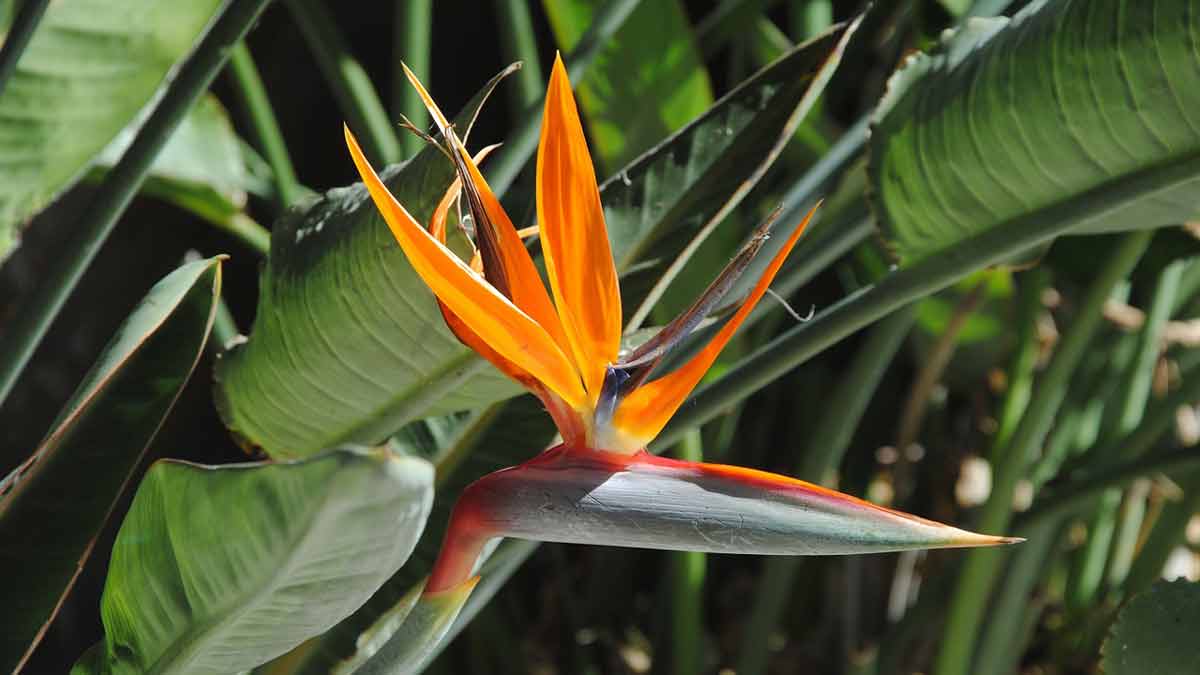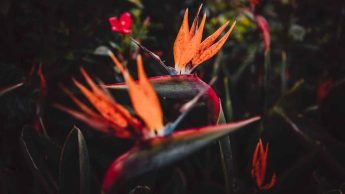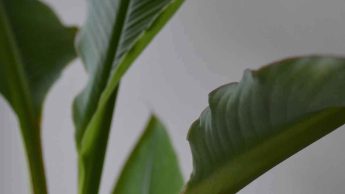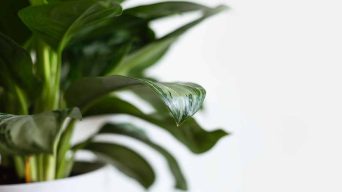The Bird of Paradise (Strelitzia reginae) is a popular houseplant known for its beautiful, exotic flowers.
They are relatively easy to care for, but sometimes their leaves may start to curl.
This can be caused by several factors, including improper watering, low humidity, or even too much sun.
But don’t worry; there are some simple solutions to help your plant return to its lush, green self in no time.
Why Are My Bird of Paradise Leaves Curling and How Can You Fix It?
Several reasons your Bird of Paradise leaves may start to curl.
Here are some of the most common causes and what you can do to fix them:
1. Underwatering
Bird of Paradise leaves typically curl when the plant is not getting enough water.
While Bird of Paradises are native to Africa and used to hot, dry conditions, they still need a steady water supply to thrive.
When the leaves are curled, it is often an indication that the plant is not getting enough water and is starting to suffer from dehydration.
When the plant doesn’t receive enough water, the leaves will start to curl to reduce evaporation.
The edges of the leaves will become dry and brittle, and eventually, the leaves will turn brown and drop off.
How To Fix It
If you think your Bird of Paradise is not getting enough water, the best solution is to give it a good drink.
Water the plant deeply, making sure that the water reaches the roots.
Allow the soil to dry out somewhat between watering to prevent root rot.
The Bird of Paradise needs to be watered about once a week, but this will vary depending on the temperature and humidity.
Water when the top inch of soil is dry to the touch.
2. Overwatering
While underwatering is a common cause of Bird of Paradise leaves curling, overwatering can also be an issue.
When the plant gets too much water, the leaves will start to curl inwards and turn yellow.
This is because the roots are not getting enough oxygen and start to rot.
Common symptoms of overwatering include:
- Leaves that are yellow or have brown or black spots
- Stems that are soft or discolored
- Waterlogged soil
How To Fix It
If you think your Bird of Paradise is overwatered, the first thing you should do is check the soil.
You know you have a problem if it feels soggy or wet.
The best way to fix it is to let the plant dry out completely and only water it when the soil is dry to the touch.
You may also need to check your pot’s drainage to ensure that the water is not pooling at the bottom.
If the drainage is poor, you can try repotting the plant in a pot with better drainage or adding some gravel to the bottom of the current pot.
If the curling leaves are already yellow or brown, you can try to cut them off.
This will help the plant to focus its energy on new growth.
3. Nutrient Deficiencies
Bird of Paradise leaves commonly curl as a result of nutrient deficiencies.
While the plant requires different nutrients to thrive, the three most essential are nitrogen, phosphorus, and potassium.
A lack of any of these nutrients can cause Bird of Paradise leaves to curl.
Nitrogen promotes growth, and a deficiency will lead to stunted growth and yellowing leaves.
Phosphorus is essential for root development, and a deficiency can cause Bird of Paradise leaves to curl and turn brown.
Potassium helps the plant resist disease and pests, and a deficiency can cause Bird of Paradise leaves to curl and drop off.
How To Fix It
The best way to correct nutrient deficiencies is to use a complete fertilizer containing all three essential nutrients.
Fertilize Bird of Paradise plants every two weeks during the growing season and once a month during the winter.
If you suspect that your plant is suffering from a specific nutrient deficiency, you can use a fertilizer that is high in that nutrient.
For example, if your plant has yellow leaves, it may lack nitrogen.
In this case, you can use a nitrogen-rich fertilizer to help correct the deficiency.
You can also add compost or other organic matter to the soil to help improve its nutrient content.
4. Pests
Pests are another common cause of Bird of Paradise leaves curling.
Several pests can attack the plant, including aphids, caterpillars, and mites.
These pests will suck the sap from the leaves, causing them to curl and turn yellow.
Pests can also spread diseases, which can further damage the plant.
You can tell if your plant has pests by looking for the following signs:
- Sticky leaves
- Holes in the leaves
- Discolored or curled leaves
How To Fix It
If you think your plant has pests, the first thing you should do is isolate it from any other plants.
This will prevent the pests from spreading.
Next, try to remove the pests by hand. Use a cotton swab dipped in alcohol to remove aphids and pick caterpillars and mites from the leaves.
You can also use a strong spray of water to dislodge the pests.
You can use insecticidal soap or neem oil if you have a severe infestation.
These are natural and effective solutions, but follow the instructions on the label carefully.
5. Low Humidity
Another common cause of Bird of Paradise leaves curling is low humidity.
Bird of Paradise plants are native to tropical regions with high humidity levels, so they are not well adapted to tolerate periods of low humidity.
When the air is dry, the leaves lose water vapor more quickly than they can replace it through the pores, or stomata, on the leaf’s surface.
As a result, the cells in the leaves begin to shrink, causing the leaf to curl.
How To Fix It
There are several ways to increase the humidity around your Bird of Paradise plant.
One is to mist the leaves with water several times a day.
You can also use a humidifier or place the plant on a pebble tray.
A pebble tray is a tray filled with gravel, rocks, and water.
As the water evaporates, it increases the humidity around the plant.
You can also group plants together to create a microclimate.
When plants are close together, they help to increase the humidity around each other.
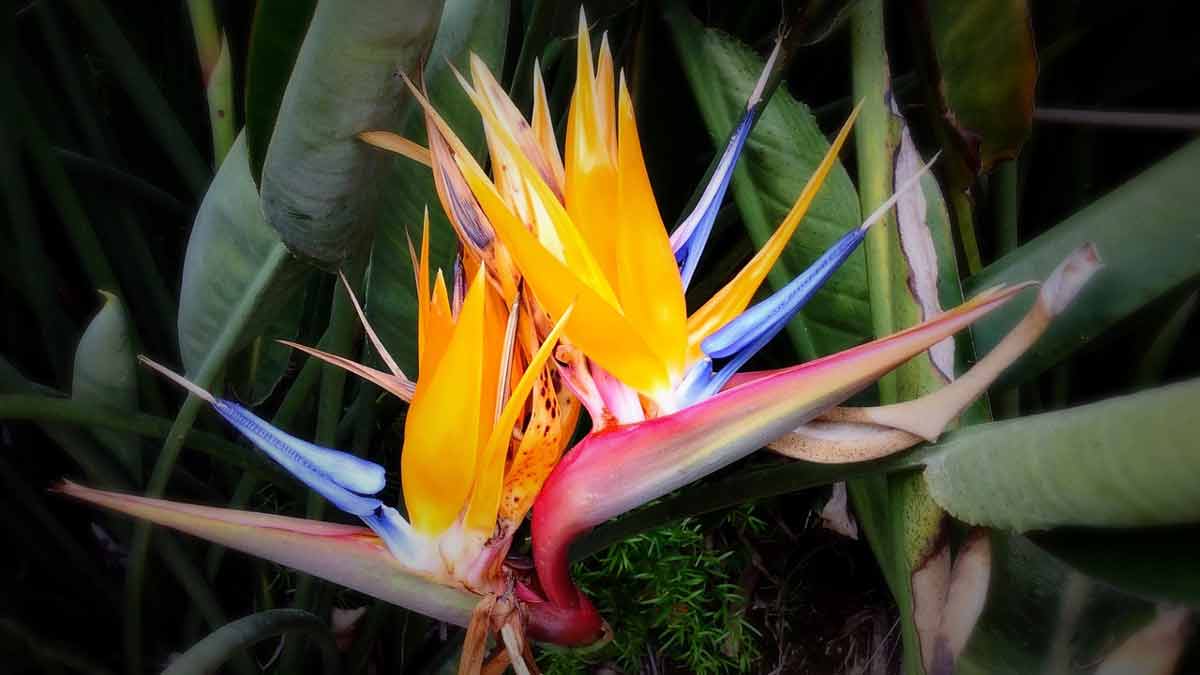
6. Temperature Extremes
Bird of Paradise leaves are known to curl under extreme temperatures.
The Bird of Paradise plant is native to South Africa and cannot tolerate cold weather.
If the temperature dips below 50 degrees Fahrenheit, the Bird of Paradise leaves will start to curl and turn brown.
On the other hand, if the temperature gets too hot, typically above 90 degrees Fahrenheit, the leaves will also start to curl.
A Bird of Paradise plant needs moderate temperatures to stay healthy.
If the temperature is too extreme, either hot or cold, the Bird of Paradise leaves will start to curl as a way to protect the plant.
How To Fix It
To fix this problem, you will need to provide your plant with the appropriate level of heat or coolness.
If it is too cold, you can move the plant indoors or use a grow light to provide additional warmth.
If it is too hot, place the plant in a cooler location or mist the leaves with water to help keep them cool.
Keep in mind that the ideal temperature range for Bird of Paradise plants is between 60 and 80 degrees Fahrenheit.
To avoid temperature extremes, place your plant in an area where it will not be exposed to drafts or direct sunlight.
7. Sunburn
Although Bird of Paradise plants need plenty of sunlight to thrive, too much sun can damage the leaves.
If the leaves are exposed to direct sunlight for too long, they can get sunburned.
When the leaves are exposed to excessive sunlight, the cells in the outer layers of the leaf begin to break down.
This results in the loss of water from the leaves, causing them to wilt and curl.
In severe cases, the leaves may turn brown or black and eventually drop off.
How To Fix It
To fix this problem, you will need to give your plant some relief from the sun.
If possible, move it to a shadier location.
When growing Bird of Paradise indoors, place the plant in an east or west-facing window.
This will give the plant plenty of bright light without exposing it to direct sunlight.
You can also try using a sheer curtain or blind to filter the light.
8. Compacted Soil
Compacted soil can also cause Bird of Paradise plant leaves to curl.
When the soil is too compacted, it doesn’t allow water or air to move freely through it.
This can cause problems for the roots of the plant because they need oxygen to stay healthy.
As a result, the leaves may start to curl as the plant tries to conserve water.
This usually occurs when the plant is overwatered or doesn’t have adequate drainage.
How To Fix It
To fix this problem, you will need to loosen the soil around the plant.
This can be done by adding some organic matter, such as compost or peat moss, to the soil.
You can also try aerating the soil with a fork or garden hose.
This will help to loosen it and improve drainage.
If the problem persists, you may need to repot the plant in a pot with drainage holes and fresh soil.
Make sure to choose a large pot to accommodate the roots of the plant.
9. Overfertilization
Fertilizers are essential for the growth and development of plants. However, too much fertilizer can cause problems such as leaf curling.
Overfertilization can lead to a build-up of salts in the soil, which can then be taken up by the plant and cause leaf curl.
This usually occurs when you use too much fertilizer or if the fertilizer is not diluted correctly before use.
Bird of paradise plants are heavy feeders and need a lot of nutrients to grow well.
However, you should be careful not to overdo it with the fertilizer.
How To Fix It
If you think your plant is suffering from overfertilization, leach the salts out of the soil by watering the plant heavily.
You can also try repotting the plant into a fresh, clean potting soil mix.
Use a diluted fertilizer solution, and be sure to follow the manufacturer’s instructions.
Fertilize your Bird of Paradise plant every two to four weeks during the growing season.
Cut back on fertilizer during winter when the plant is not actively growing.
10. Transplant Shock
Transplant shock is a common problem when moving a plant to a new pot or location.
The plant’s roots are disturbed, and the plant may go into shock as it tries to adjust to its new environment.
The roots are particularly vulnerable during this time, and they may not be able to take up enough water to meet the plant’s needs.
As a result, the leaves may begin to curl and drop off.
How To Fix It
To prevent transplant shock, handle the plant carefully when you transplant it.
Water the plant well before you start and keep the roots as intact as possible.
After transplanting, water the plant regularly and give it time to adjust to its new home.
Do not fertilize the plant for at least a month after transplanting.
If you are moving your plant outdoors, gradually give it time to acclimate to the new environment.
Move the plant into a shady spot for a week, then gradually move it into a sunnier location.
How To Prevent Bird of Paradise Leaves Curling
The best way to prevent Bird of Paradise leaf curl is to take good care of your plant and avoid any stressors that could cause the problem.
Here are some tips to help you keep your Bird of Paradise plant healthy:
- Water regularly and evenly, allowing the soil to dry out slightly between waterings.
- Fertilize monthly during the growing season with a balanced fertilizer.
- Place your plant in an area with bright indirect sunlight.
- Make sure the temperature stays consistent. Bird of Paradise plants don’t like sudden temperature changes.
- Keep the leaves clean by wiping them down with a damp cloth.
- Use well-draining soil that’s high in organic matter.
- Repot your plant every two to three years to refresh the soil and provide more room for growth.
Final Thoughts
Curled leaves on a Bird of Paradise plant are usually caused by stressors such as improper watering, too much sun, or pests.
You can prevent leaf curl by taking good care of your plant and providing the proper environment.
If you notice your Bird of Paradise leaves curling, don’t worry – there are a few things you can do to fix the problem.
Start by identifying the cause, then take steps to address it.
With some care and attention, your plant will be healthy and thriving in no time.

